– Nucleus.
sharon kalunda answered the question on May 29, 2019 at 06:01
- State two distinguishing features of members of the phylum chordata.(Solved)
State two distinguishing features of members of the phylum chordata.
Date posted: May 29, 2019. Answers (1)
- A form three on a field trip collected termites and brought them to the laboratory. State two characteristics features thatwould enable her to group them...(Solved)
A form three on a field trip collected termites and brought them to the laboratory. State two characteristics features that would enable her to group them under phylum arthropoda.
Date posted: May 29, 2019. Answers (1)
- Give a reason why ammonia is converted to urea.(Solved)
Give a reason why ammonia is converted to urea.
Date posted: May 29, 2019. Answers (1)
- Name a condition characterized by insufficient production of:-
i) Anti diuretic hormone
ii) Insulin(Solved)
Name a condition characterized by insufficient production of:-
i) Anti diuretic hormone
ii) Insulin
Date posted: May 29, 2019. Answers (1)
- The process shown by a flow chart diagram occurs in the mammalian body
i) Name the organ where the process occurs
ii) Name the metabolic process...(Solved)
The process shown by a flow chart diagram occurs in the mammalian body

i) Name the organ where the process occurs
ii) Name the metabolic process that gives rise to gas W in the body
Date posted: May 29, 2019. Answers (1)
- The diagram below shows half a flower.
(a) Identify the structure that develop into a fruit wall after fertilization.
(b) Name the structure labelled B and...(Solved)
The diagram below shows half a flower.

(a) Identify the structure that develop into a fruit wall after fertilization.
(b) Name the structure labelled B and F.
(c) What is the function of the structure labelled G?
Date posted: May 28, 2019. Answers (1)
- How do the etiolated plant differ from the normal plant?(Solved)
How do the etiolated plant differ from the normal plant?
Date posted: May 28, 2019. Answers (1)
- Name the part of an organelle where the Photolysis of water occur;(Solved)
Name the part of an organelle where the Photolysis of water occur;
Date posted: May 28, 2019. Answers (1)
- Name the part of an organelle where the Carbon IV oxide fixation occur;(Solved)
Name the part of an organelle where the Carbon IV oxide fixation occur;
Date posted: May 28, 2019. Answers (1)
- Explain why Blood group AB is a universal recipient.(Solved)
Explain why Blood group AB is a universal recipient.
Date posted: May 28, 2019. Answers (1)
- Explain why Blood group O is a universal donor.(Solved)
Explain why Blood group O is a universal donor.
Date posted: May 28, 2019. Answers (1)
- Below are photographs of specimens obtained from plants. Examine the photographs.
(a) For each of the specimens, name the mode of pollination and the features that...(Solved)
Below are photographs of specimens obtained from plants. Examine the photographs.
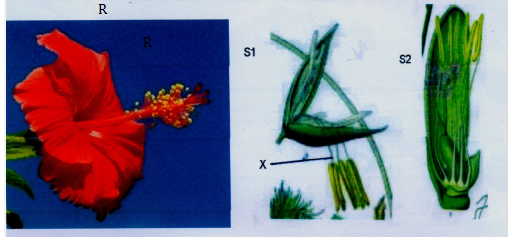
(a) For each of the specimens, name the mode of pollination and the features that adapt the spaciments to the mode of pollination.
Specimen R
- Mode of pollination.
- Adaptive features.
Specimen S1
- Mode of pollination.
- Adaptive features.
(b) Label any four parts on specimen R.
(c) Name the structure labeled X on specimen S1.
(d) Using observable features only state two differences between R and S1.
(e) With a reason, name the class of the spermatophyta to which specimen R and S2 belongs.
Specimen R.
Class
Reason
Specimen S2.
Class
Reason
Date posted: May 28, 2019. Answers (1)
- i) Name the fluid which is found in the joint area of two bones.
ii) State the function of the fluid named above.(Solved)
i) Name the fluid which is found in the joint area of two bones.
ii) State the function of the fluid named above.
Date posted: May 28, 2019. Answers (1)
- Use the photographs below to answer the question which follow.
a) Name four types of joints found in the photographs.
b) Name the bones labelled A,...(Solved)
Use the photographs below to answer the question which follow.
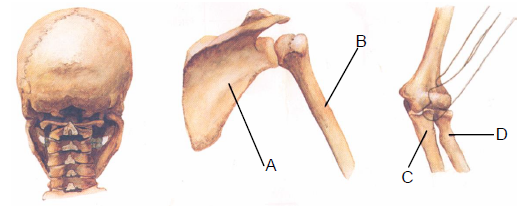
a) Name four types of joints found in the photographs.
b) Name the bones labelled A, B and C.
c) Name the cavity where
i) bone B fits into bone A.
ii) bone B fits into bone C and D.
Date posted: May 28, 2019. Answers (1)
- a)Construct a dichotomous key to key out the following organisms using the following steps
Step 1: Body covering
Step 2: Animal with 3pairs of walking limbs or...(Solved)
a)Construct a dichotomous key to key out the following organisms using the following steps

Step 1: Body covering
Step 2: Animal with 3pairs of walking limbs or more
Step 3: Animals with four pairs of legs
Step 4 : Number of walking limbs per segment.
b) With reasons state the class to which the organisms belong.
i) S. gregaria
ii) S. coleopata
Date posted: May 28, 2019. Answers (1)
- State the type of germination exhibited by seedlings in photograph I below. Give reasons.
Type of germination.
Reasons.(Solved)
State the type of germination exhibited by seedlings in photograph I below. Give reasons.
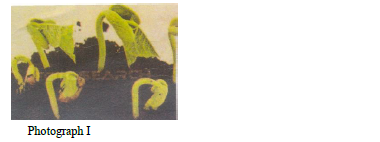
Type of germination.
Reasons.
Date posted: May 28, 2019. Answers (1)
- Use the photographs on plant responses to stimuli to answer the questions that follow.
The photograph shows various phenomena.
(i) Sate the type of response shown, the...(Solved)
Use the photographs on plant responses to stimuli to answer the questions that follow.
The photograph shows various phenomena.

(i) Sate the type of response shown, the seedlings in photograph G..
(ii) Explain the mechanism of the response shown in question (i) above.
(iii) Using observable features only compare the seedlings in photograph G and H.
(iv) State the biological phenomenon shown by seedling in photograph H.
Date posted: May 28, 2019. Answers (1)
- Study the photographs of organs in mammalian circulatory system and answer the questions that follow.
(a) Identify the organ whose photograph appears in 2.1.
(b) Name...(Solved)
Study the photographs of organs in mammalian circulatory system and answer the questions that follow.

(a) Identify the organ whose photograph appears in 2.1.
(b) Name the tissue marked W in the photograph 2.1a and state its function.
Tissue W.
Function.
(c) The photograph 2.1b is a longitudinal section of organs in photograph 2.1a. Observe it and answer the question that follow.
Name the parts marked 1, 2, 3, 4 and 4.
Date posted: May 28, 2019. Answers (1)
- Examine the following diagrams labelled E and F.
With reasons identify E and F
Identify E
Reasons
Identify F
Reasons(Solved)
Examine the following diagrams labelled E and F.
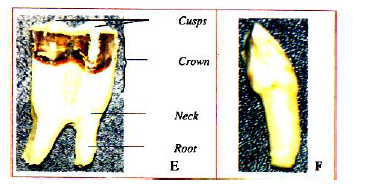
With reasons identify E and F
Identify E
Reasons
Identify F
Reasons
Date posted: May 28, 2019. Answers (1)
- Below are photographs of specimen labelled L and M which were obtained from different animals.
Examine them.
a) Suggest the diet of each of the animals whose...(Solved)
Below are photographs of specimen labelled L and M which were obtained from different animals.
Examine them.
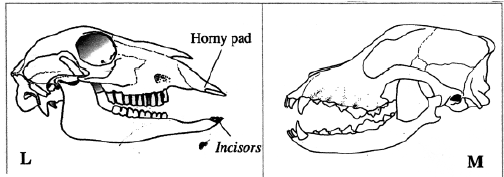
a) Suggest the diet of each of the animals whose skulls are shown in the diagram. Give reasons for your answer.
b) Write the dental formula of the animal whose skull are shown in diagrams L and M.
Date posted: May 28, 2019. Answers (1)